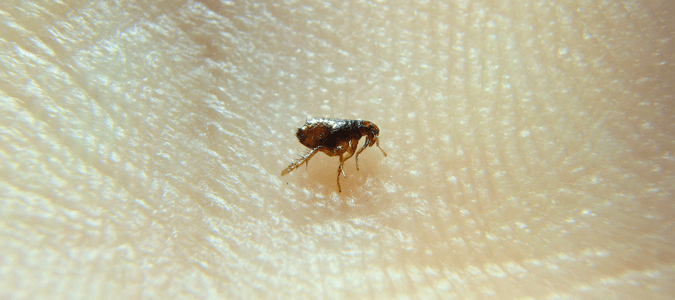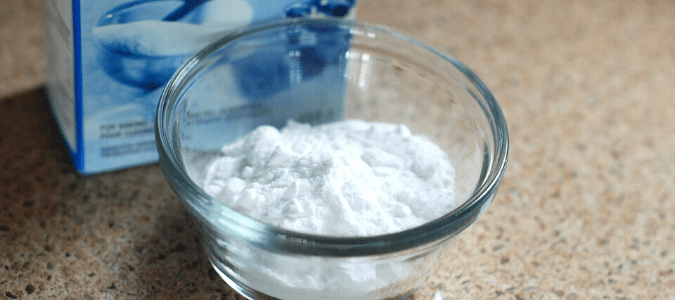Can You See Flea Eggs? Controlling An Infestation

Fleas are tiny, wingless insects, about the size and color of a speck of black pepper, that are visible to the naked eye. But, what about fleas in other life stages—can you see flea eggs? This is a common question from people who are dealing with a flea infestation in their homes, or from anyone who is worried they might have a flea problem. Unfortunately, flea eggs are even tinier than adult fleas. They are pale in color and about the size of a grain of sand, which makes them very difficult to see. They also aren’t normally found in the fur of a dog or cat the way adult fleas are. Since they are hard and smooth, flea eggs typically fall out of an animal’s fur on to bedding or the floor below.
You don’t need to see flea eggs, however, to assume they’re present and proceed accordingly. Learning about flea eggs is smart if you’re dealing with a flea infestation in your home, as this type of pest problem is difficult to control and must be treated in a comprehensive manner. To successfully control fleas, these pests must be eliminated at all stages of their life cycle, including the eggs, larvae and pupae as well as adults. Though it’s difficult for most people to spot flea eggs in their pets’ bedding, carpets or elsewhere in the home, there are plenty of other signs that can signal a flea problem that needs to be addressed.
Here are several possible hints that you may have fleas living and breeding in your home:
- Dogs, cats or other furry pets that frequently scratch, chew or lick at their fur.
- Live fleas or flea “dirt”—what appears to be dark, reddish-brown specks of dirt—visible in your pet’s fur. Fleas might be anywhere on the pet’s body. While flea dirt (which are feces, or waste products) can also show up anywhere, it is often spotted on the skin of the animal’s stomach or where the lower torso meets the back legs.
- Redness or visible irritation on your pet’s skin, or patches of fur loss. Both could be the result of an allergic reaction to flea bites.
- Flea “dirt” or tiny white specks—which could be flea eggs—on your pet’s bedding, or on a sofa or other piece of furniture where your pet spends lots of time.
- Little red bites or welts on your skin, often around your ankles and feet. These bites may or may not be itchy. Some people are acutely allergic to flea bites and may develop hives in response to them.
If you aren’t sure if your pets have fleas, you can use a special flea comb to comb through their fur. If you collect anything that looks like dirt, drop it into a bowl of water; if it’s flea dirt, it will dissolve into a reddish-brown stain in the water. Also, even if you only spot one flea, you could still have an infestation. To be sure, you can always reach out to a pest management specialist to inspect your home for fleas and recommend a comprehensive course of treatment.
In the U.S., the most common type of flea is called the cat flea, but this type of flea can also be found on dogs and other mammals. Fleas are parasites that live at least part of their lives on their animal hosts, gaining warmth from the host’s fur and body heat, and feeding on the host’s blood for sustenance.
In nature, fleas live on other mammals besides just dogs and cats. These pests can happily thrive on squirrels, rats, raccoons and other outdoor critters, though they do typically die off in cold weather. Most people with flea infestations in their homes have pets that brought these tiny insects in from the outdoors, having “caught” these parasites from the yard due to squirrels and other wild animals with flea-infested fur. Fleas thrive indoors since most of us keep our homes climate-controlled. If indoor fleas aren’t treated properly, they won’t die out in winter as outdoor fleas do, since they aren’t affected by the seasons.
Even people without pets can suffer from flea infestations in their homes, however; these can result from a critter problem, such as a mouse or rat infestation. Rats and other animal pests have been known to nest inside people’s walls, attics or crawl spaces, introducing fleas to the home when they bring the smaller pests in on their bodies. If the critter pest dies, the fleas must seek a new living host—and may invade the home’s living spaces in their search.
Still, it’s far more common for a home to develop a flea problem thanks to a pet with fleas. If you have a furry friend that scratches frequently, fleas may be the culprit, and the problem could be extensive—meaning that the fleas may have infested not just your poor pup but also parts of your house. Carpeted floors give flea eggs plenty of shelter to develop into larvae; dog or cat bedding can also shelter flea eggs and larvae, as can any furniture where pets spend lots of time.
If you suspect you have a flea problem in your home, it’s wise to contact a pest control professional to help you address the problem from all angles. Fleas are incredibly prolific breeders, which makes them very difficult to control. Measures like washing pet bedding and vacuuming the carpets in your home will help limit flea population growth, but these measures aren’t enough to get rid of a flea infestation. Pest control specialists can recommend and apply the most effective techniques for your home and yard so you and your pets don’t have to worry about any more itchy bites.
Although hiring a reliable pest management professional is typically the most effective way to handle a flea infestation, there are home remedies that have varying results.

Fleas In Carpet: Baking Soda Remedy—Does It Work?
For people who find fleas in carpet, baking soda is an appealing remedy to help control these pests. After all, it’s considered to be a non-toxic method of pest control for those with young children. But, is it an effective way to kill or repel adult fleas or their eggs, larvae or pupae? Unfortunately, as nice as it would be to kill off fleas simply by sprinkling a little baking soda onto your pet’s fur and bedding or the rug where Fido likes to take his afternoon naps, baking soda is not actually an effective flea control product.
There are several flea remedies touted by natural product enthusiasts to work that aren’t actually effective at keeping fleas at bay. Some of these products and remedies can be helpful as one tool among many that you might use to control fleas, but most aren’t scientifically proven to help control fleas. Some methods, such as adding garlic and brewer’s yeast to your pet’s food, can actually be harmful to your pet, as large doses of garlic can be toxic for dogs. Other substances, such as boric acid, have been found to be dangerous to dogs in laboratory studies.
Even anecdotally, most natural flea remedies are rarely reported to be anything more than moderately effective, especially when dealing with an established flea infestation. Another issue with using natural and do-it-yourself remedies to try to control fleas is that doing so usually just prolongs the issue. Most people who try these methods find over time that they simply can’t control the fleas on their own, particularly as these pests reproduce. Meanwhile, they and their pets may have been suffering from the effects of the flea bites, when they could have tried a more effective approach from the beginning to stop fleas from biting.
Keeping your home as clean as possible, including frequently vacuuming carpets and rugs, cleaning sofa cushion covers and laundering pet bedding in hot water and with high heat, are all good and easy ways to assist in the fight against fleas. But the most effective way to control fleas, especially if you’re dealing with an actual infestation in your home, is with the help of a flea control specialist. These professionals can draw on their expertise to launch a multi-faceted and multi-phased fight against fleas living on your pet, in your home and in your yard, to ensure that adult fleas, as well as their eggs, larvae and pupae, are eliminated for good.

Flea Dirt But No Fleas On Dog: What Should You Do?
If you’ve ever parted your pet’s fur and spotted what looked like reddish-black specks of dirt, what you were looking at may not have been dirt at all—at least, not dirt of the sort that comes from the ground outside. Rather, it may have been flea “dirt”. Flea dirt is actually the feces of adult fleas, and it is reddish-black in color because it is made up of animal (or human) blood that isn’t fully digested. If you see flea dirt but no fleas on your dog or cat buddies living in your home, you may wonder what to do. If you don’t see any actual, live fleas, do you need to worry about a flea infestation?
The short answer to that question is yes, you should still be concerned about a flea infestation, for a variety of reasons. First, if flea dirt is present on your dog or cat, it’s a strong indication that your pet is hosting one or more live fleas that have laid eggs. One of the primary functions of flea dirt is to feed flea larvae, so they can develop into adult fleas that will reproduce and continue the life cycle. When adult fleas lay eggs, the eggs fall out of the animal host’s fur to rest wherever they land—often, in Fido’s bedding, or deep in the fibers of a rug or carpet in your home.
Similarly, when adult fleas excrete feces, it falls to where the flea eggs fell. Once the eggs hatch into larvae, the larvae feed on the flea dirt. Within a week or two, flea larvae enter the pupae stage of their life cycle by spinning cocoons around themselves. Once they emerge from their cocoons, they will be fully developed adult fleas, ready to reproduce, lay eggs and begin the life cycle anew. A full flea life cycle can last anywhere from a month to two-and-a-half months, depending on many variables, including temperature and humidity. However, if conditions are right, fleas can stay in the pupae stage for up to six months before hatching.
Another reason to take flea dirt on your pet seriously is that the dog or cat itself could really suffer from flea bites—even if you, yourself, aren’t bothered by fleas. Pets can react to flea bites with painfully itchy, inflamed or flaky skin, or even fur loss. Some pets even develop anxiety or obsessive-compulsive disorders connected to ongoing flea problems; their constant itching and discomfort can cause them to lick themselves obsessively and display other symptoms of anxiety.
To keep your pets in good physical and emotional health and protect your home and family, it’s wise to contact a pest control specialist at the first sign of fleas in your home. That way, you can ensure that your flea problem is dealt with properly, so that it won’t turn into an ongoing infestation that takes a lot of time and effort to eliminate.
Chem-free Can Eliminate Your Flea Problem
Dealing with a flea problem on your own can feel like an endless, draining chore. Instead of trying to take this job on yourself, contact Chem-free Organic Pest Control. We offer customized pest management solutions that put your family first, so you, your family and your pets can feel comfortable again.

